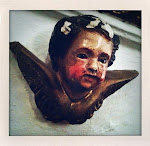
(Photo: Ana Ma. Pimentel)
¿Are you looking for a great variety of Mexican crafts (on display and for sale)? This museum is one of the must see for those who love tradition and folklore. Its Art Deco building houses an impressive collection of everyday ornamental, religious or magical objects mixing the idea of naïve art & materials with Mexican identity.
You’re greeted in different indigenous languages as you cross the entrance: in the main yard, The History train, built with several crafts and materials such as black mud or Huichol art, shows key situations on Mexican history.
The visitor can access the third floor by the elevator or through the stairs, which happen to be guarded by monumental alebrije giants. Room 1 shows off the skill of craftsmen and their use of stone, natural fibers or bark paper.
It’s hard not to be attracted by the imposing mural of Miguel Covarrubias which shares the room with interactive computers. The toys, miniatures, textiles and pottery from the room 2 will certainly amaze the visitor. Shapes and colors from the piñatas on display are flattering to the eye.
Your choice: visiting the multimedia lounge or walking through halls 3 and 4… Masks, judas, votive offerings or little saints and the devotion of Mexicans to their religion and magical imagery will definitely surprise the viewer while three enormous judas will receive and watch him through the exhibition.
Whoever wants to perceive the identity of the Mexican Nation must always do so from the standpoint of half-caste origins. Since we are the result of two ancient cultures which if separately are very important, combined take an unbelievable creative force.
Since after the exhibit you will rush to the Souvenir Shop, we strongly advice you run with caution.
FYI:
· On Sundays, storytellers will entertain both children and grownups with different themes according to the time of the year.
· The Folk Art Museum offers crafts workshops for both artisans and visitors or children.
· For those who would rather take a break while enjoying a film, the documentary (short films, lasting 10 - 12 minutes) on traditions and craftsmanship is a great option, this month’s screening: The Mexican feather art.
· On the courtyard and hallways, there are tables with facsimile newspaper articles from the Revolutionary era to 1967 with key information on historical and social events Mexico passed through.
· This museum is the starting point for the Monumental Alebrije Parade which strides each year all the way through Reforma Ave.
· The building has a convenient layout for the disabled or handicap.
· The Museum provides guided tours. You must call Public Services Coordinator Urania Nuñez: 5510-2201, ext. 128, to arrange a meeting.
· Toys, textiles, books, postcards, jewelry, decoration items, pottery, brass, paper and glass work, paintings, musical instruments, furniture, miniatures and countless curiosities are on sale at the museum shop.
· There are open competitions on different subjects such as piñata or alebrijes. You can also submit your contribution to the Train of History.
· Café Punta del Cielo is a coffee shop located within the grounds of the MAP and offers high quality coffee for those who want to make a stop during their visit.
VIP Tip:
Chinatown, home to Chinese immigrants from Canton and Guangdong who arrived in the '70s, is located nearby, at Dolores Street and Marroquin on one side of the Alameda, and is an excellent option to take a look and enjoy good dishes after visiting the FAM.
Getting there:
The Folk Art Museum is located on Independencia Street between the streets of Revillagigedo and José Azueta.
Easy references are:
• Metropólitan Theater, located almost in front of the museum.
• Juárez Metro Station (subway), which is 2 blocks away.
• Hidalgo Metro Station (subway), located 5 blocks away from the FAM.
• The Alameda Central Park, one block away from the museum.
Horario:
Tuesday to Sunday from 10 am to 6 pm.
Thursdays from 10 am and will stay open until 9 pm.
Public access will be allowed until 30 minutes before closing time.
On Mondays, the museum will be closed for maintenance.
The museum will also be closed on December 24, 25 and 31 and January 1st of each year.
Museum Fee:
$ 40.00 M.N.
Fee exemptions:
• Children under 13 years old.
• Disabled or Handicapped.
• People over 60 years with INAPAM ID.
• Students and teachers with ID.
• Indigenous and Artisans with ID.
On Sundays admission is free.
Ana María Pimentel Arámbula


No comments:
Post a Comment
people said